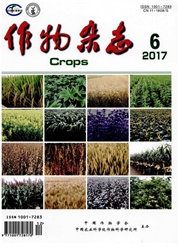

 中文摘要:
中文摘要:
为了探究不同供氮水平下氮素利用相关酶的贡献程度,采用单株砂培培养,严格控制氮素等营养供应,用15N饲喂追踪。研究了氮高效油菜品系742谷氨酰胺合成酶(GS)和谷氨酸合成酶(GOGAT)交替抑制情况下,油菜的子粒氮素转运和积累量、氮素损失的情况以及对氮素利用率的影响。结果表明,氮胁迫与正常供氮2种情况下,在抑制GOGAT活性时,氮素利用效率最低,子粒中氮素转运比例最低,氮素损失最大,在抑制GS时影响较小。缺氮时GOGAT对子粒氮素积累、作物产量形成及作物体内氮素再利用影响很大,GS影响较小。同时发现在生育后期,正常供氮与氮胁迫2种情况下子粒中来源于营养器官前期积累的氮素达到50%~70%。油菜营养器官生育前期积累的氮素主要用于氮素再利用,子粒中积累的氮素大部分来源于营养器官。
 英文摘要:
英文摘要:
In order to explore the contribution of enzymes accounting for nitrogen reutilization in Brassica napus under nitrogen stress and normal nitrogen supplied condition, the strain 742, with inhibiting glutamine synthetase (GS)and glutamate synthetase(GOGAT) reciprocally was used to measure the difference of transportation and accumulation of grain nitrogen .loss of nitrogen and nitrogen use efficiency. The results showed that both of the two conditions under GOGAT inhibitor strain 742 variety present lowest nitrogen use efficiency, minimum transportation nitrogen in grain and maximum nitrogen loss. Less influence took place in GS which reached to 50% -70% of the grain nitrogen de- rived from storage nitrogen of vegetative organs. GOGAT had the largest effect on accumulation of grain and nitrogen reutilization in plant while GS had little influence. The storage of nitrogen during early growth stage was mainly used for nitrogen remobilization and accumulation of grain nitrogen derived from vegetative organs.
 同期刊论文项目
同期刊论文项目
 同项目期刊论文
同项目期刊论文
 Responses of seed yield and quality to nitrogen application levels in two oilseed rape varieties dif
Responses of seed yield and quality to nitrogen application levels in two oilseed rape varieties dif 期刊信息
期刊信息
